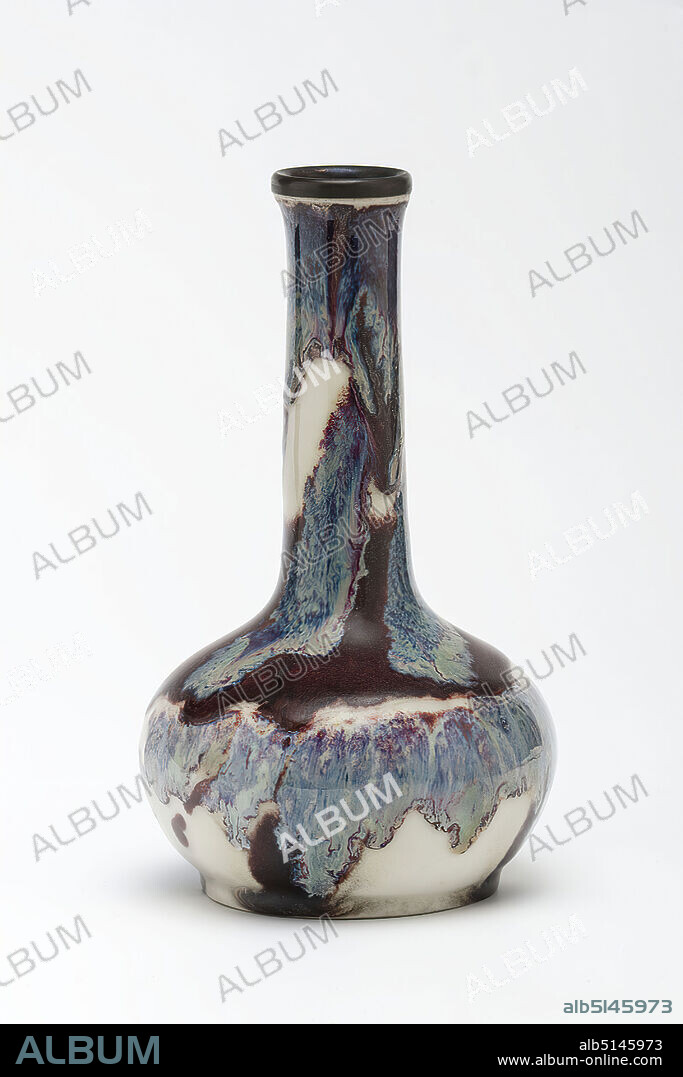alb5145973
KPM Königliche Porzellanmanufaktur Berlin, Hermann August Seger, Vase, Porcelain, glazed, Total: Height: 21,80 cm; Diameter: 12,80 cm, Porcelain mark: Sceptre mark, Sgr. P, Ornamental objects, Art Nouveau, On a smooth, flat base stands a man with a full beard and curly wreath of hair, balancing on his head a naked, plump little woman, the so-called Baubo He himself is dressed in a long robe with fringes at the hem, under which an overlong phallus peeps out. He holds the woman by her feet with both hands. She herself grabs the shame with her right hand under the full stomach. In her left she holds a club. She has thrown an animal skin over her head, which is knotted over her chest. Her long hair is held by a band. The group of figures is to be connected with the pronounced reference to sexuality especially with fertility cult. At the same time, however, it also picks up an episode from the myth about Heracles: Baubo is dressed in lion skin and a club with the attributes of Hero. Thus, the bearded man is probably a sign of the hero. The story of Heracles and Omphale, where the hero had to lay down his equipment and wear women's clothes, should be remembered. The figure belongs to the group of the so-called Fayum terracottas. In Alexandria, the international, Greek-influenced center of Egypt, lives a multicultural society of Egyptians, Orientals, Greeks, Romans, Jews and others, whose different religious ideas are gradually blending together. Insights into this world of faith are provided by the so-called Fayum terracottas. They are part of the religious household, children's toys, knick-knacks, but also cult symbols, grave goods, pilgrimage images, votive offerings and magical objects for banishing evil forces. They can be found in houses, graves and sanctuaries.

|
Zu einem anderen Lightbox hinzufügen |
|
Zu einem anderen Lightbox hinzufügen |



Haben Sie bereits ein Konto? Anmelden
Sie haben kein Konto? Registrieren
Dieses Bild kaufen.
Nutzung auswählen:

Untertitel:
Siehe automatische Übersetzung
KPM Königliche Porzellanmanufaktur Berlin, Hermann August Seger, Vase, Porcelain, glazed, Total: Height: 21,80 cm; Diameter: 12,80 cm, Porcelain mark: Sceptre mark, Sgr. P, Ornamental objects, Art Nouveau, On a smooth, flat base stands a man with a full beard and curly wreath of hair, balancing on his head a naked, plump little woman, the so-called Baubo He himself is dressed in a long robe with fringes at the hem, under which an overlong phallus peeps out. He holds the woman by her feet with both hands. She herself grabs the shame with her right hand under the full stomach. In her left she holds a club. She has thrown an animal skin over her head, which is knotted over her chest. Her long hair is held by a band. The group of figures is to be connected with the pronounced reference to sexuality especially with fertility cult. At the same time, however, it also picks up an episode from the myth about Heracles: Baubo is dressed in lion skin and a club with the attributes of Hero. Thus, the bearded man is probably a sign of the hero. The story of Heracles and Omphale, where the hero had to lay down his equipment and wear women's clothes, should be remembered. The figure belongs to the group of the so-called Fayum terracottas. In Alexandria, the international, Greek-influenced center of Egypt, lives a multicultural society of Egyptians, Orientals, Greeks, Romans, Jews and others, whose different religious ideas are gradually blending together. Insights into this world of faith are provided by the so-called Fayum terracottas. They are part of the religious household, children's toys, knick-knacks, but also cult symbols, grave goods, pilgrimage images, votive offerings and magical objects for banishing evil forces. They can be found in houses, graves and sanctuaries.
Persönlichkeiten:
Bildnachweis:
Album / quintlox
Freigaben (Releases):
Bildgröße:
2880 x 4320 px | 35.6 MB
Druckgröße:
24.4 x 36.6 cm | 9.6 x 14.4 in (300 dpi)
Schlüsselwörter:
AEGYPTEN • AKT (MALEREI) • ART NOUVEAU • AUSRÜSTUNG • BALANCEAKT • BALANCIEREN • DEKORATION • ENTBLÖSSUNG • ENTBLÖßT • ERZAEHLUNG • ERZÄHLUNG • FRAU • FRAUEN • GLAUBE • GLEICHGEWICHT • GRUPPE • HAAR (HAARE) • HAARE (HAAR) • HAARE (LANGE) • HAARE • HAENDE • HAND • HAUS • HELD • HELDEN, ALLE • HEROS • HÄNDE • HÄUSER • INTERNATIONAL • JUDE • JUDEN • JUEDISCH • JUGENDSTIL • KLUB • KOPF (ANATOMIE) • KOPF • LANGES HAAR • MANN • MODERNISMUS • NACKT (NACKTHEIT) • NACKT • NIPPES • ORNAMENT • ORNAMENTE • STIL: JUGENDSTIL • TIERHAUT • TUMBAS • VERZIEHRUNG • VERZIERUNG • VOLLBART • WEIBCHEN • WELT • WOMAN • ZEIT • ZIERDE • ÄGYPTEN
 Pinterest
Pinterest Twitter
Twitter Facebook
Facebook Link kopieren
Link kopieren Email
Email
